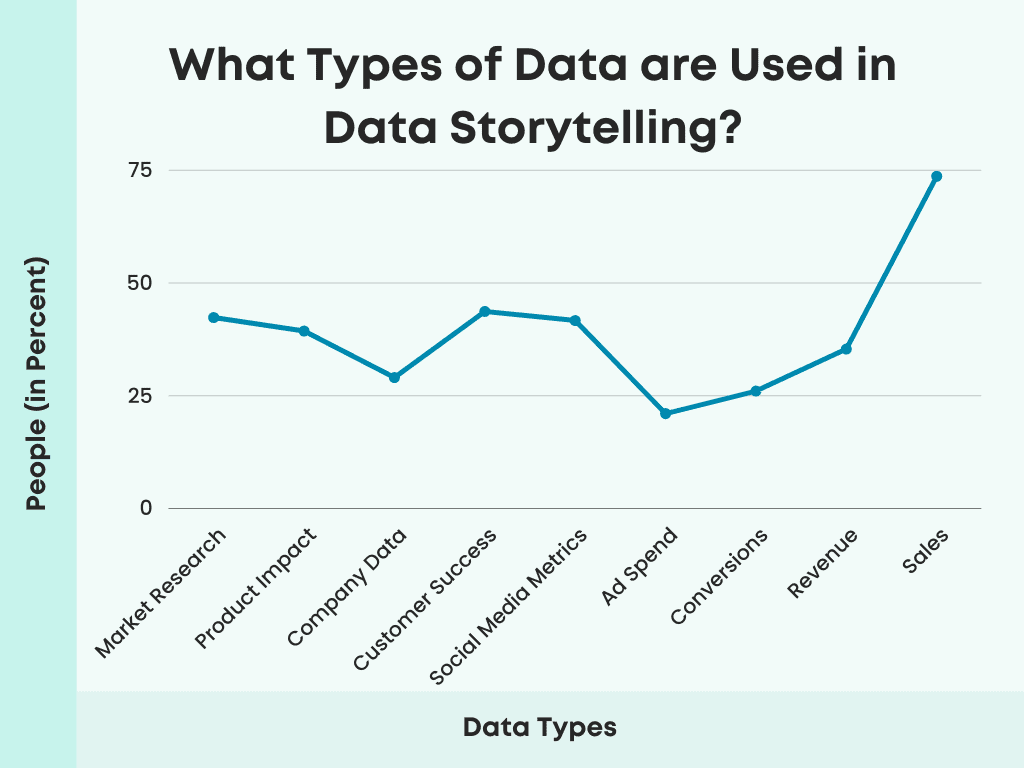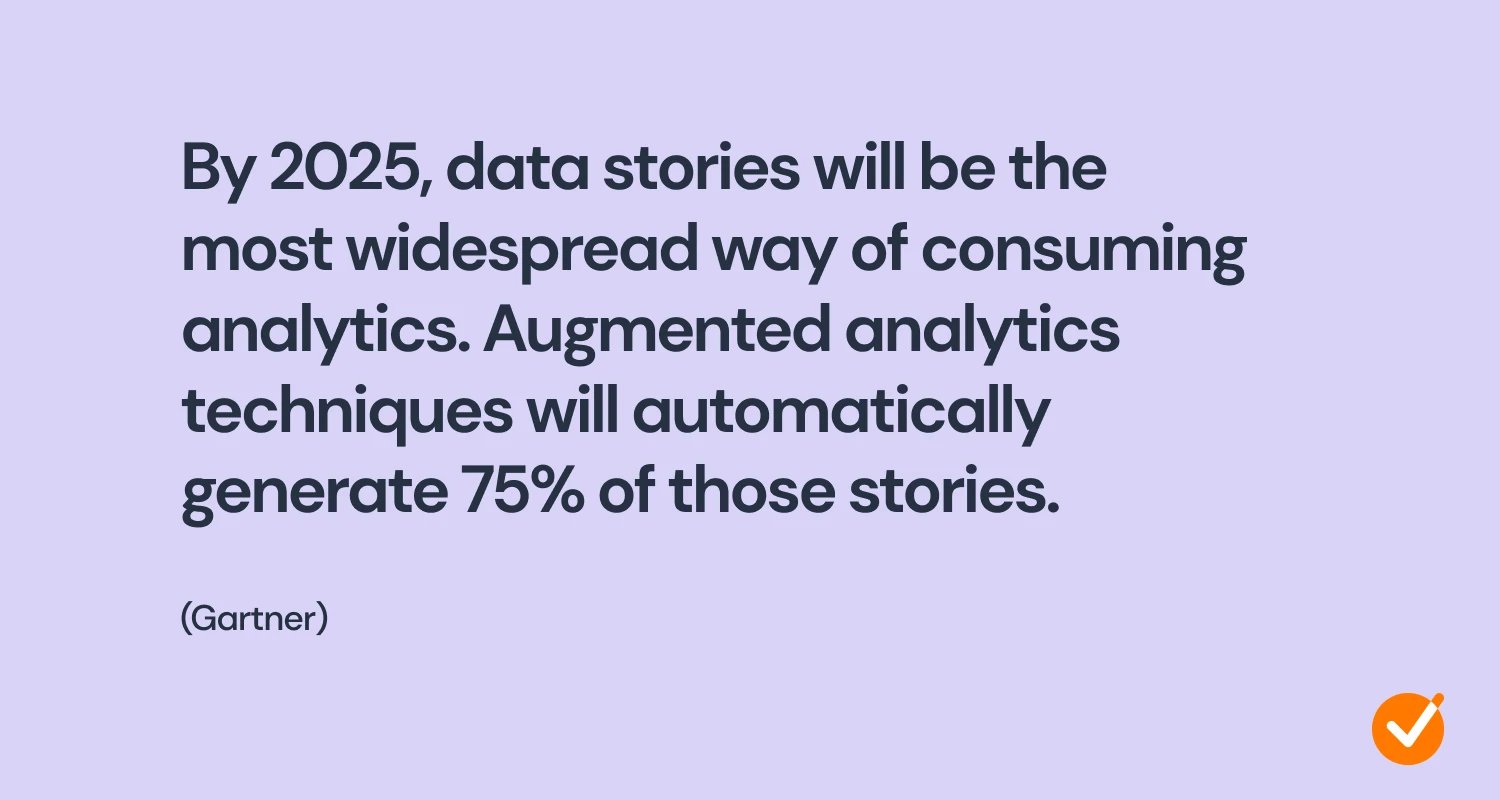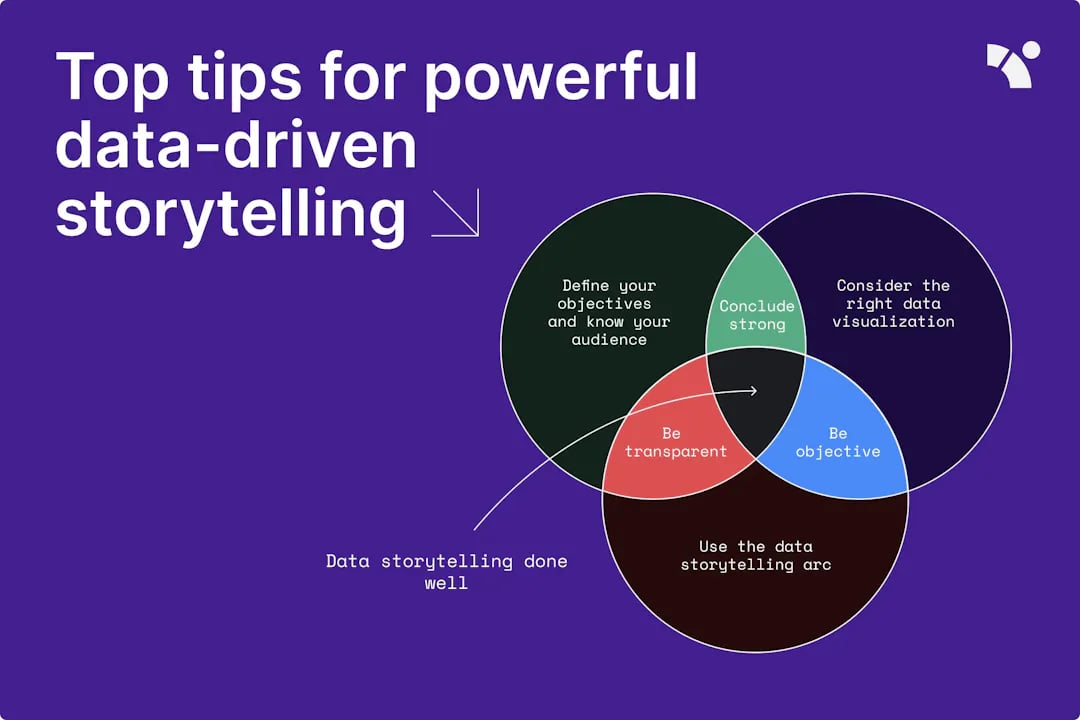What do you look for when writing compelling sales content? Do you focus on the greatness of your product or service, the benefits it will bring, or the needs it will fulfill?
It’s all very well telling people how good something is, but people tend to respond best to cold, hard proof.
Enter data.
We generate 328.77 million terabytes of data each day. You use it to analyze performance, forecast demand, inform marketing, and more. So why not include it in your sales storytelling too?
Data can be a powerful tool when used correctly. But just what is data storytelling and what benefits can it bring?
What is data storytelling?

(Source: Leapmesh)
Put simply, data storytelling involves using data to convey sales and marketing messages to customers (and sometimes colleagues). You could see it as the meeting of old and new, where the age-old skill of telling stories melds with the modern collection and use of data.
Don’t worry – it doesn’t mean including the type of content you need a degree for! Unless you’re a data-focused technology provider, you probably don’t want to be giving a snowflake schema example in your blog posts. Instead, think about easy-to-understand facts – what percentage of people did x, or how many new customers did x bring in?
With that in mind, here are some of the main things to consider when employing data storytelling:
- Useful data should be an integral part of the content.
- You need to use data in such a way that it can encourage a change in your audience. That change can encompass everything from improved understanding to a purchasing decision.
- Your content should follow traditional storytelling ‘rules.’ You should have a narrative that flows, a fundamental question/problem at the heart of the story, and a conclusion or resolution that answers questions.
Like traditional stories, your content can take different forms. It could be textual, but it could also be videos, podcasts, or animation. For example, you could explain the benefits of a UK domain name in a blog post and include a table detailing how many orders companies had in the UK before and after a domain change.
A good data story will engage the reader and meet your goals, which can vary greatly. For example, your goals may be to increase awareness of your brand or convert potential customers into paying customers.
7 benefits of data storytelling
As with anything new, you'll see what benefits it will bring before investing time and/or money in it, right? Luckily, you’re already collecting and using data daily, so the initial investment is minimal, while the benefits are huge.
1. Brand awareness
Whether you’re a small business or a large corporation, brand awareness should be important. This isn’t just about potential customers recognizing your organization’s name; it’s also about how people perceive you. If their perception of you is positive, then you have a higher chance of converting them into paying customers.
For example, let’s say your business offers third-party risk management services. By presenting data in your content that highlights your success stories, you can raise awareness of your brand and back it up. You’re not just saying you’re good – you’re proving it.
2. The human touch
Let’s be honest here. Even though data is a valuable resource, there are times when it can just seem like lists and lists of numbers. By incorporating data in your storytelling, you add a human touch and a certain degree of ‘warmth’ to what can often be perceived as cold and sterile.
If you just presented data as those seemingly endless lists of figures, many people would click away. But by adding background and a narrative to that data, you create something more engaging and more likely to resonate with people. In an age of automation and machines, the human touch can make a real difference to your sales pitches and is something good salespeople can use to their advantage.
3. Breaking down complexity

(Source: Forbes)
Data can be complex and confusing to many. Without context, not everyone within your organization will understand the data provided, which also holds true for your demographic targets. Storytelling that incorporates data allows you to break down these walls of complexity to ensure anyone can understand it.
Let’s say you had to write a piece about Elasticsearch examples and ensure it’s accessible to non-tech professionals. In addition to using data to show why it works so well, you can incorporate a narrative to explain what it is and what it does. By combining the two, you remove any barriers to comprehension and can help highlight things that may make a difference in purchasing decisions.
4. Providing value and insights
One of the key roles of data is providing insights. It informs business decisions that may cost millions of dollars and lets you know things you are doing that don’t work well (and vice versa). Used in sales content, it can give insights into the usefulness of your products or services that can inform your customer base. The data in your CRM can be a great source of information for your data storytelling efforts, as can data gathered from feedback surveys.
For example, if you have data showing that buying a certain tool can improve productivity by an average of 15%, your sales team can use that in a story they present to potential clients.

(Source: Gartner)
Many factors can make your business stand out from the crowd. Perhaps you’re well-known for the innovation that comes from your use of brainstorming sessions or the trendy aesthetic of your products.
No matter what you’re known for, it’s important to establish trust and credibility for your brand. You can start that journey by weaving a narrative that includes compelling statistics and well-written content.
Your data may show you’re good at something. It may even show you’re the best (or one of the best). However, the majority of people may not comprehend standalone data. Data storytelling can show you’re an expert in your field and can compel people to listen to your views and thoughts.
6. Better accessibility
When you transform your data into data storytelling, you’re increasing the reach and accessibility of any content. When aiming for better sales figures, you want your content read by as many potential customers as possible.
For instance, let’s say you wrote a piece of content on SCM forecasting. The data alone might be challenging for anyone unfamiliar with the practice. But if we include data in a story-based piece of content, more people will likely read your piece as it presents the data in an informative – and hopefully entertaining – way.
7. Relevancy
How often have you looked at a list of data and wondered how it’s relevant to you? Data storytelling can bridge that gap and explain why it matters. If a potential customer wants to scale a managed service provider company, you need to show them how your tools can help. That means presenting relevant data with an accompanying narrative that explains what that data means to them.
If something appears irrelevant to the reader, they’ll simply look elsewhere. Tying data and narrative together can help highlight why your statistics and other information mean something. At the end of the day, illustrating relevancy can be what makes the difference between a sale and someone walking away.
The takeaway

(Source: Y42)
Your data is already valuable, and you likely value content that engages and informs. When you combine those two things, you’ll find that you have a tactic that increases your reach and drives improved sales figures.
As with any tactic, it’s about getting it right. Look at areas where you already use data in your sales and marketing efforts and how you can improve that by adding a narrative flow. Even when you use data in content such as infographics, could it be enhanced by telling the story of the information you are trying to impart?
At the end of the day, your success in data storytelling will be measured by data on conversions and sales.




